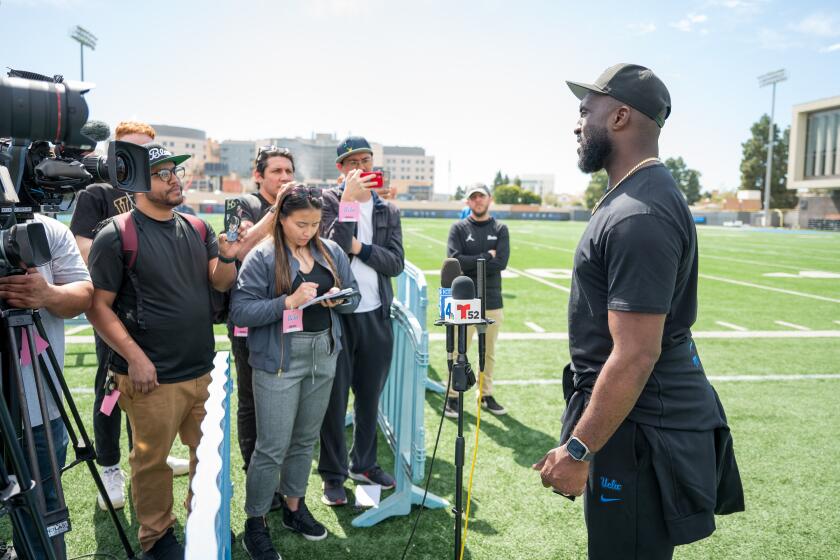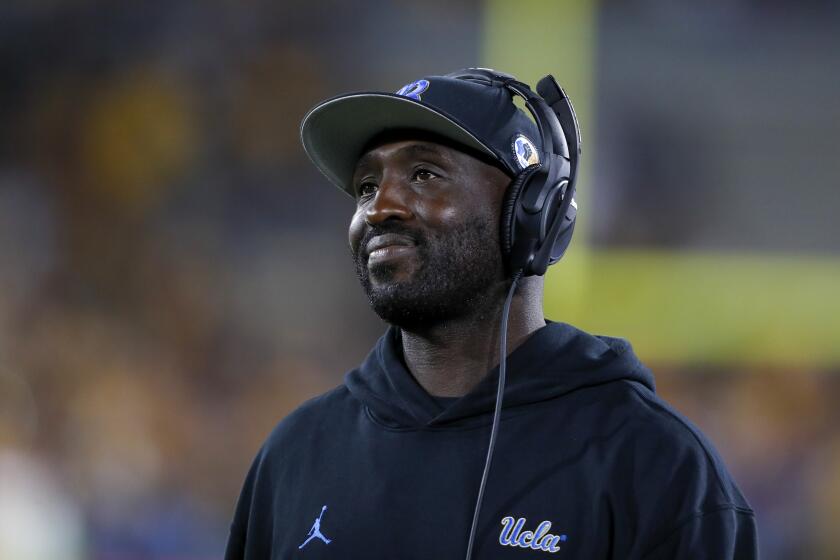Football crowds at the Rose Bowl have dwindled along with UCLA’s fortunes, but a turnaround may not be far off
It wasn’t too long ago that the hottest football ticket in town was for UCLA, not USC.
The year was 1998, and behind Heisman Trophy candidate Cade McNown the Bruins averaged a school-record 73,709 in attendance for five games at the Rose Bowl while the Trojans drew 60,903 per game at the Coliseum.
“I can still remember UCLA officials walking around the press box area talking about how they had to take the bunting off the seats because they had too many people standing outside,” said Chris Roberts, the Bruins’ play-by-by announcer since 1992.
“Such an exciting time. You could just feel it. Everybody wore powder blue, ready to see the Bruins play.”
It’s a much different fan landscape now as the Bruins prepare for their home opener Saturday night against Rice at the Rose Bowl.
USC is two-time reigning national champion and coming off a 2004 season in which its average home crowd was a Pacific 10 Conference-record 85,229. At UCLA, which averaged 65,515 last year, officials are excited about reaching 30,000 in season-ticket sales after falling below that a year ago.
To UCLA Athletic Director Dan Guerrero, it comes down to winning.
“When we were riding high and beating the Trojans eight years in a row, there was a spike in our attendance,” said Guerrero, a former Bruin baseball second baseman who took over the athletic program in April 2002. “Your fan base is going to be more supportive when you have success. ... Los Angeles fans like to support winners.
“I would love to say that our fan base is unconditional. But there isn’t a team in Los Angeles, except maybe the Dodgers, that can say that. ... Over the years, you’ll see higher numbers when a team is winning and lower when it’s losing.”
UCLA’s latest experience with this trend began following the 1998 high-water season. The Bruins won a school-record 20 consecutive games over a span of the the 1997 and 1998 seasons, but things began to go south after a 34-17 victory over USC on Nov. 21, 1998.
UCLA closed out the season with losses at Miami and to Wisconsin in the Rose Bowl game. In 1999, the Bruins lost three of their first five games and their attendance average at the Rose Bowl dropped nearly 24,000, to an average of 49,825, the third-lowest since UCLA moved to Pasadena from the Coliseum in 1982.
“The ‘90s were special for Bruin fans,” said Roberts, who details the history of UCLA and the Rose Bowl in a book, “Stadium Stories: UCLA Bruins.”
“When Cade McNown hit the field, UCLA fans felt like there was no way we could lose,” Roberts added. “He always seemed to find a way to get it done.”
In January 2004, UCLA agreed to a 20-year extension to play at the Rose Bowl, which included a planned $14-million renovation for new locker rooms, seismic improvements and a media facility.
The deal has worked for both sides, according to Rose Bowl General Manager Darryl Dunn.
“It’s been a pretty good fit,” Dunn said. “We’re excited about the improvements that will start being worked on next year.”
UCLA, which gets 92% of the gross ticket sales and television revenues and half of concessions and merchandise sales, relies heavily on football attendance to finance other sports in its athletic program.
“It’s vital, critical, imperative, I can’t stress it any more,” Guerrero said about UCLA’s dependency on the football gate. “When you look at the funding sources for Division I-A athletic programs, you are looking at five things: Gate receipts, donations, corporate sponsorships, revenue-sharing dollars and merchandise type things.
“A big chunk of your support base comes from your economic drivers, and for a place like UCLA, it’s men’s basketball and football. If football is not generating revenue at the gate, obviously, that hurts you.”
Last season, UCLA finished fifth in the Pac-10 with a 4-4 record -- and fifth in the league in attendance.
This season, UCLA doesn’t play USC at the Rose Bowl and the Bruins have only four home games after school begins later this month. Those are indicators of major attendance downers in most years.
Even so, school officials expect attendance to reach about the level it did in 2001, when the Bruins averaged 66,613 in another season they didn’t have the Trojans at home.
“There’s a lot more optimism and buzz about the program even though we finished with a loss at the end of last season,” Guerrero said. “Our fan base sees some promise in this team and are recognizing that there’s a chance we could be pretty good.
“And in Los Angeles, if you don’t prove yourself, people are not going to show up.”
*
(BEGIN TEXT OF INFOBOX)
UCLA crowd
UCLA football teams’ average attendance at the Rose Bowl the last 10 seasons, including record and games per season:
Year W-L Attendance Games2004 6-6 60,515 62003 6-7 56,636 62002 8-5 65,396 62001 7-4 66,613 52000 6-6 67,280 71999 4-7 49,825 61998 10-2 73,709 51997 10-2 54,589 61996 5-6 57,532 51995 7-5 49,107 61994 5-6 51,396 6
Go beyond the scoreboard
Get the latest on L.A.'s teams in the daily Sports Report newsletter.
You may occasionally receive promotional content from the Los Angeles Times.



